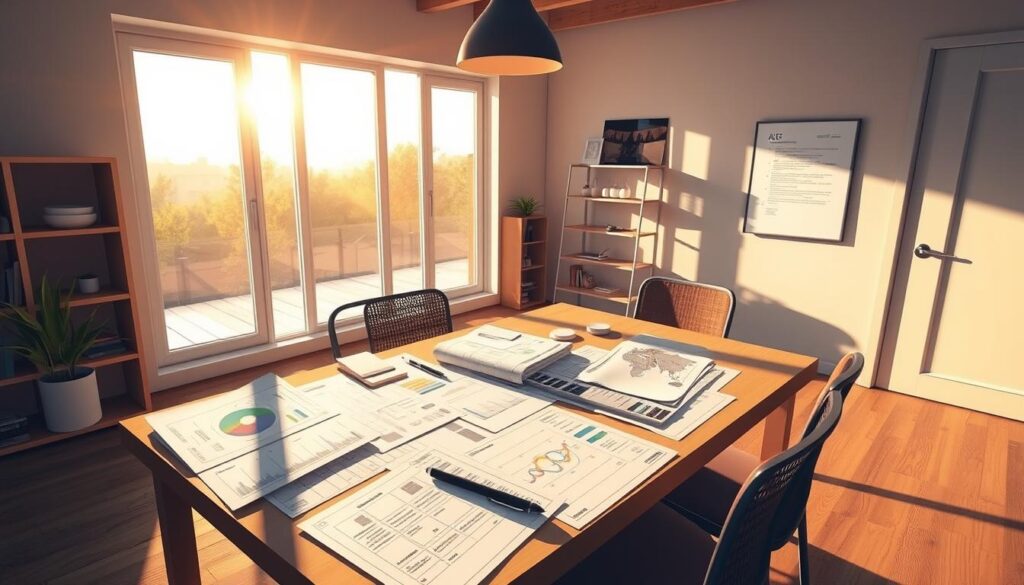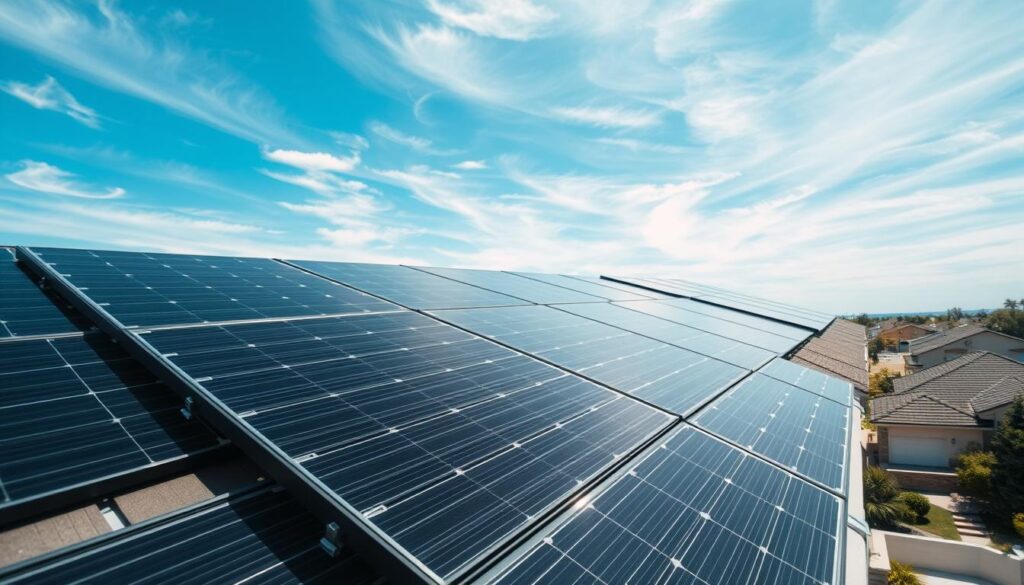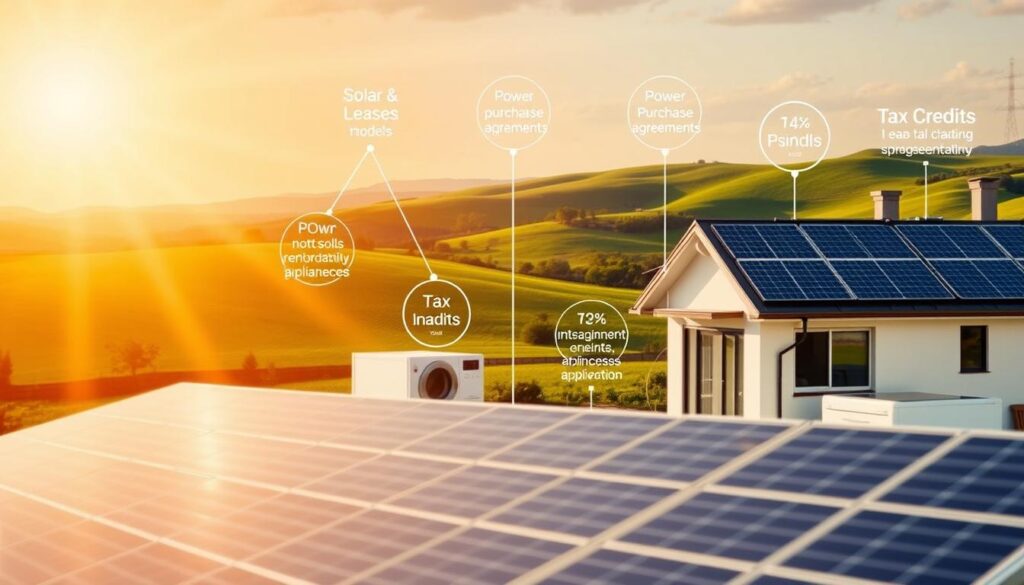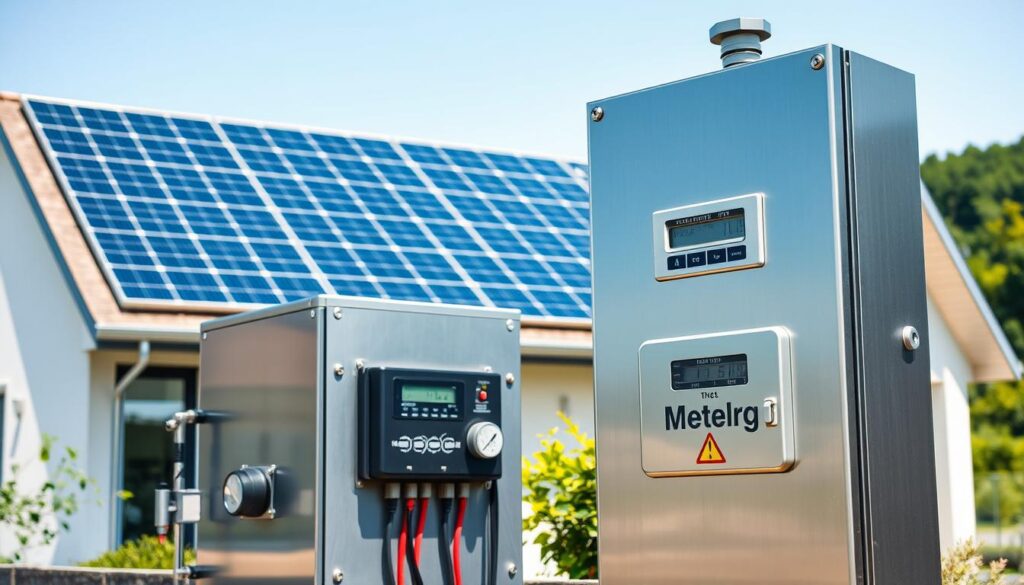Switching to a solar energy system can transform the way you power your life. With advancements in technology and government incentives, these systems are now more affordable than ever. Since 2008, hundreds of thousands of solar panels have been installed across the U.S., thanks to investments from the Department of Energy’s SETO program.
Homeowners are enjoying reduced electricity bills and long-term financial savings. Beyond the cost benefits, adopting solar energy helps reduce carbon emissions, making it a win for both your wallet and the planet. The average lifespan of these systems is 25 years, requiring minimal maintenance while delivering consistent performance.
This article will guide you through the process of installing a solar panel setup, exploring financing options, and maintaining your energy system. Whether you’re looking to save money or contribute to a greener future, now is the perfect time to explore solar solutions.
Key Takeaways
- Solar energy systems significantly reduce electricity bills and offer long-term savings.
- Government incentives and technological advancements have made solar more affordable.
- These systems have an average lifespan of 25 years with minimal maintenance.
- Adopting solar energy helps reduce carbon emissions and supports environmental sustainability.
- This guide covers installation, financing, and maintenance for a seamless transition to solar.
Introduction to Solar Energy for Homeowners
Harnessing the sun’s energy has become a game-changer for modern living. It’s a clean, renewable source that’s transforming how we power our lives. With advancements in technology, it’s now easier than ever to tap into this abundant resource.
Understanding Solar Energy and Its Benefits
Solar energy works by converting sunlight into electricity using panels. This process, known as the photovoltaic effect, is both efficient and sustainable. By adopting this technology, you can significantly reduce your reliance on traditional energy sources.
One of the biggest advantages is the reduction in utility bills. Many homeowners see a noticeable drop in their monthly expenses. Additionally, using solar helps cut down on carbon emissions, making it a win for both your wallet and the planet.
Why Go Solar in the United States?
In the U.S., the push toward renewable energy is stronger than ever. Government incentives and tax credits make going solar more affordable. Plus, with rising electricity costs, it’s a smart financial move for many families.
According to recent data, homes with solar panels sell for an average of $14,329 more than those without. This makes it not just an investment in your energy needs but also in your property’s value.
By choosing solar, you’re contributing to a cleaner, greener future. It’s a decision that benefits you, your community, and the environment.
Benefits of a Home Solar Power System
Investing in renewable energy can transform your monthly expenses. By harnessing the sun’s power, you can significantly reduce your reliance on traditional sources. This shift not only saves money but also supports a cleaner environment.
Reducing Utility Bills and Energy Costs
One of the most immediate benefits is the drop in your monthly bills. Many homeowners report a noticeable decrease in their expenses after installation. Over time, these savings add up, making it a smart financial decision.
For example, the average U.S. household can save thousands of dollars over the lifespan of their system. With rising electricity costs, this is a practical way to protect your budget.
- Lower monthly bills: Generate your own electricity and reduce reliance on the grid.
- Long-term savings: Enjoy consistent savings for decades with minimal maintenance.
- Energy independence: Take control of your energy needs and avoid price hikes.
Switching to renewable sources also has environmental benefits. By reducing your carbon footprint, you’re contributing to a healthier planet. This makes it a win-win for both your wallet and the environment.
According to recent data, nearly 4 million American households are already benefiting from this technology. With government incentives like the 30% federal tax credit, the upfront costs are more manageable than ever.
By choosing renewable energy, you’re not just saving money—you’re investing in a sustainable future. It’s a decision that pays off in more ways than one.
Assessing Your Home’s Energy Needs for Solar Installation
Understanding your energy consumption is the first step toward a sustainable future. By evaluating your current usage, you can determine the right solution for your household. This process ensures efficiency and maximizes savings.

Evaluating Your Current Electricity Usage
Start by reviewing your utility bills. Look for patterns in your monthly consumption, especially during peak hours. This data helps identify areas where you can reduce usage and save money.
For example, the average U.S. household consumes about 877 kWh per month. By analyzing this, you can estimate the size of the panel setup needed to meet your needs.
Determining the Appropriate System Size
Several factors influence the ideal system size. These include roof space, local climate, and energy usage trends. A professional assessment can provide accurate recommendations tailored to your home.
For instance, a medium-sized household typically requires a 6-8 kW setup. This ensures sufficient energy generation while keeping costs manageable. Comparing price per watt across installers can also help you make an informed decision.
Working with experts ensures your system is optimized for efficiency. They consider shading, orientation, and tilt to maximize energy production. This approach guarantees long-term savings and sustainability.
Choosing Between Grid-Tied and Off-Grid Solar Systems
Deciding on the right energy setup can feel overwhelming, but understanding your options simplifies the process. Two popular choices are grid-tied and off-grid systems. Each has unique benefits and considerations, making it essential to evaluate your needs before making a decision.
Advantages of a Grid-Tied Solar Energy System
Grid-tied systems are the most common option for homeowners. They connect to the local utility grid, allowing you to draw electricity when needed. One major benefit is net metering, where excess energy you produce is sent back to the grid for credits. This can significantly reduce your monthly bill.
These systems are also cost-effective. They require less equipment than off-grid setups, lowering initial costs. Additionally, they provide a reliable backup if your panels don’t generate enough energy. For many homeowners, this balance of savings and convenience makes grid-tied systems an ideal choice.
Exploring Off-Grid Options for Complete Independence
Off-grid systems are perfect for those seeking full energy independence. They don’t rely on the utility grid, making them ideal for remote locations. Instead, they store energy in batteries for use when the sun isn’t shining. This ensures a consistent power supply, even during outages.
However, off-grid systems come with higher upfront costs. They require more equipment, including multiple battery banks, to function effectively. Despite this, many homeowners value the freedom and reliability they offer. If you live in an area with frequent power interruptions, this option might be worth the investment.
When choosing between grid-tied and off-grid systems, consider your energy needs, location, and budget. Both options provide unique advantages, ensuring there’s a solution tailored to your lifestyle.
Step-by-Step Guide to Installing Solar Panels
Starting your journey toward renewable energy begins with a well-planned installation process. Whether you’re looking to reduce your utility bill or increase your energy independence, this guide will walk you through the essential steps.

Pre-Installation Assessments and Permitting
Before any work begins, a thorough assessment is crucial. A qualified company will evaluate your roof condition, energy needs, and local regulations. This step ensures your setup is both efficient and compliant.
Permitting is another critical phase. Depending on your location, this can take anywhere from a few weeks to several months. Working with professionals ensures all paperwork is handled correctly, avoiding delays.
Roof-Mounted Versus Ground-Mounted Options
Choosing between roof-mounted and ground-mounted setups depends on your property and preferences. Roof-mounted systems are popular for their space efficiency and ease of installation. However, they require a sturdy roof and proper orientation for optimal performance.
Ground-mounted systems, on the other hand, offer flexibility in placement and easier maintenance. They’re ideal for properties with ample land but may involve higher upfront costs. Both options have unique advantages, so consider your needs carefully.
Working with a trusted company ensures your project is completed safely and efficiently. They’ll handle everything from design to final inspections, making the process seamless. By following these steps, you’ll be well on your way to enjoying the benefits of renewable energy.
DIY Solar Power System Kits and Customization
Taking control of your energy production has never been easier with DIY kits. These comprehensive packages include everything you need to get started, making them a popular choice for those who enjoy hands-on projects. Whether you’re looking to save on installation costs or customize your setup, DIY kits offer flexibility and convenience.
Understanding DIY Solar Panel Kits
DIY kits are designed to simplify the process of setting up renewable energy. They typically include panels, inverters, mounting hardware, and connectors. Some kits even come with batteries for backup storage. This all-in-one approach ensures you have the essential components to start generating energy right away.
Customization is a key feature of these kits. Depending on your energy needs, you can choose the size and type of panels, inverters, and battery storage. This flexibility allows you to tailor the system to your specific requirements, whether you’re powering a small cabin or a larger property.
When it comes to pricing, the price per watt can vary based on the components included. On average, DIY kits are more affordable than professional installations, saving you up to 60% on costs. However, it’s important to factor in additional expenses like permits and tools.
While DIY kits are user-friendly, there are times when professional help might be necessary. For example, if your roof requires structural modifications or if you’re unsure about electrical connections, hiring an expert ensures safety and compliance.
One of the biggest advantages of DIY kits is the availability of credits and incentives. Many states offer tax credits for equipment and installation, reducing your overall investment. By taking advantage of these programs, you can maximize your savings while contributing to a greener future.
Installing a DIY kit can be a rewarding experience. Not only do you gain energy independence, but you also enjoy the satisfaction of completing the project yourself. With the right guide and preparation, you can create a system that meets your energy goals and fits your budget.
Financing Options and Incentives for Solar Installation
Exploring financial options for renewable energy can make your transition smoother and more affordable. With a variety of incentives and flexible payment plans, adopting clean energy is within reach for many households. Understanding the available programs can help you maximize savings and reduce upfront costs.

Exploring Federal and Local Tax Credits
The federal government offers a 30% tax credit on the cost of renewable energy installations. This incentive, known as the Investment Tax Credit (ITC), applies to both equipment and installation expenses. Many states also provide additional credits, making it even more affordable to switch.
For example, states like New York and Maryland offer favorable programs that can significantly reduce your investment. These incentives are designed to encourage adoption and make clean energy accessible to a wider area of the population.
Financing, Leasing, and Power Purchase Agreements
If upfront costs are a concern, there are several financing options available. Solar loans allow you to pay for your system over time, typically with fixed monthly payments. Leasing and Power Purchase Agreements (PPAs) offer alternative routes, where you pay for the electricity produced rather than owning the system outright.
- Solar Loans: Fixed payments over 5 to 25 years, with ownership at the end of the term.
- Leasing: Lower upfront costs, but no ownership of the system.
- PPAs: Pay for the energy you use, often at a lower rate than traditional utilities.
Each option has its benefits, so it’s important to evaluate your financial goals and choose the one that fits your needs.
Increased electricity produced by your system can enhance its value. Programs like net metering allow you to earn credits for excess energy sent back to the grid. This not only reduces your bills but also increases the return on your investment.
“With the right financial incentives, renewable energy becomes an affordable and sustainable choice for homeowners across the country.”
By taking advantage of these programs, you can enjoy long-term savings and contribute to a cleaner environment. Start by researching the options available in your area and consult with experts to make the most of your investment.
Maximizing Savings with Net Metering and Battery Storage
Maximizing your energy savings is easier than ever with modern solutions. By combining net metering and battery storage, you can significantly reduce your bills and enhance energy reliability. These tools not only save you money but also ensure your rooftop solar setup works at its best.

How Net Metering Can Offset Your Bills
Net metering allows you to earn credits for excess energy your panels produce. For example, if you generate more electricity than you use, it’s sent back to the grid. In return, you receive credits that reduce your monthly bill.
In states like New Jersey and Florida, full retail net metering compensates you at the same rate you pay for electricity. This means you can offset your costs effectively. For instance, sending 50 kWh back to the grid could earn you $7.50 in credits, depending on your local rates.
The Role of Energy Storage Systems
Battery storage adds another layer of efficiency to your project. It stores excess energy for use during cloudy days or power outages. This ensures you always have a reliable supply, even when the sun isn’t shining.
For example, a Tesla Powerwall can store energy for later use, maximizing your savings. While the upfront cost is around $15,500, tax credits can reduce this to $12,600. Over time, this investment pays off by lowering your reliance on the grid.
“With net metering and battery storage, you’re not just saving money—you’re building a more resilient energy future.”
Choosing the right size for your setup is crucial. A properly sized system ensures you generate enough energy to meet your needs without overspending. Working with professionals can help you design a solution tailored to your household.
By integrating these technologies, you can enjoy long-term savings and peace of mind. Whether you’re looking to cut costs or increase energy independence, net metering and battery storage are smart choices for any rooftop solar project.
Maintaining and Optimizing Your Solar Energy System
Ensuring your energy setup runs efficiently requires consistent care and attention. Regular maintenance not only extends the lifespan of your equipment but also maximizes its performance. By staying proactive, you can avoid costly repairs and enjoy uninterrupted energy production.
Why Regular Maintenance Matters
Routine checks are essential to keep your system in top shape. Dust, debris, and weather conditions can affect performance over time. Cleaning panels twice a year can boost efficiency by up to 20%. Additionally, inspecting for physical damage, like cracks or shading, ensures optimal energy output.
Using Monitoring Tools for Real-Time Data
Modern monitoring systems provide access to real-time energy data. These tools allow you to track production, identify issues early, and make informed adjustments. For example, some systems can analyze individual panel performance, helping you pinpoint areas for improvement.
- Routine Inspections: Check for dirt, damage, and shading every six months.
- Performance Evaluations: Use monitoring tools to track energy production and efficiency.
- Professional Services: Schedule expert inspections every two years for a thorough assessment.
Cost-Saving Strategies Through Proactive Care
Proactive maintenance can save you up to 30% on future repair costs. For instance, adjusting panel angles four to five times a year maximizes sunlight exposure. Combining this with smart technology, like automated cleaning systems, further enhances efficiency and reduces manual effort.
“Regular upkeep not only saves money but also ensures your system operates at peak performance for years to come.”
By investing in regular care and leveraging advanced tools, you can optimize your energy setup and enjoy long-term savings. Whether it’s cleaning panels or using smart monitoring, these steps ensure your system remains reliable and efficient.
Overcoming Common Challenges in Solar Installation
Navigating the complexities of solar installation can feel daunting, but with the right approach, challenges become manageable. One of the most common hurdles is dealing with local permitting. Delays in approvals can push back your project timeline, but working with experienced service providers can streamline the process.
Another issue is crew availability. High demand for installations can lead to scheduling conflicts. To avoid this, plan ahead and book your team early. This ensures your project stays on track and minimizes downtime.
Technical obstacles, like roof compatibility or shading, can also arise. Using advanced tools for site analysis helps identify these issues before installation begins. This proactive approach saves time and reduces unexpected costs.
Unexpected expenses are another concern. Budgeting for contingencies and exploring financing options can ease financial strain. Many service providers offer flexible payment plans, making it easier to manage costs.
“With the right preparation and professional guidance, every challenge can be turned into an advantage.”
Real-life examples show how these strategies work. For instance, a homeowner in California faced permitting delays but partnered with a local expert to expedite approvals. This collaboration not only saved time but also ensured compliance with all regulations.
Energy storage solutions, like batteries, are another advantage. They store excess energy for use during cloudy days or outages, ensuring a reliable supply. Smart grid technologies further enhance efficiency, making your setup more resilient.
By anticipating challenges and leveraging the right tools and expertise, you can overcome obstacles and enjoy the benefits of clean energy. Whether it’s navigating permits or optimizing your setup, these steps ensure a smooth and successful installation.
Expert Tips and Tools for a Successful Solar Project
Achieving a successful renewable energy project requires careful planning and the right expertise. From selecting a qualified installer to enhancing energy efficiency, these steps ensure your setup is efficient and cost-effective.
How to Choose a Qualified Installer
Selecting the right professional is crucial for a smooth installing solar process. Look for companies with certifications like NABCEP (North American Board of Certified Energy Practitioners). These credentials ensure the installer meets industry standards.
Ask for references and check online reviews. A reputable source of information is the Better Business Bureau (BBB). This helps you gauge the company’s reliability and customer satisfaction.
Obtain multiple bids to compare purchase costs and service quality. This not only saves money but also gives you a better understanding of what to expect. Don’t hesitate to ask detailed questions about warranties, timelines, and equipment.
Energy Efficiency Upgrades to Enhance Your System
Complement your setup with energy-efficient upgrades. Smart thermostats and LED lighting reduce overall consumption, maximizing the benefits of your net metering setup. These upgrades are cost-effective and easy to implement.
Consider adding insulation to your property. This minimizes heat loss, reducing the workload on your heating and cooling systems. Energy-efficient appliances also play a significant role in lowering utility bills.
Monitoring tools provide real-time data on energy usage. For example, systems like Tesla’s Solar Roof tiles offer detailed insights, helping you optimize performance. These tools ensure your setup operates at peak efficiency.
“Investing in energy efficiency upgrades not only enhances your system but also maximizes long-term savings.”
By following these tips and leveraging the right tools, you can ensure a successful renewable energy project. Whether it’s choosing the right installer or enhancing efficiency, these steps pave the way for a sustainable future.
Conclusion
Embracing renewable energy solutions offers a path to both financial savings and environmental stewardship. By understanding your energy need, you can tailor a setup that maximizes efficiency and cost-effectiveness. Proper solar installation ensures long-term performance and reliability.
The benefits are clear: reduced utility bills, increased property value, and a smaller carbon footprint. With government incentives and falling costs, now is the ideal time to make the switch. Taking this step not only saves money but also contributes to a cleaner, greener future.
Ready to take action? Start by evaluating your energy need and exploring solar installation options. With the right plan, you can enjoy the rewards of sustainable energy for years to come.
